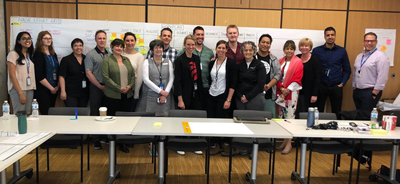Introducing the Green Zone: More efficient emergency care

By Amber Daugherty

Part of the team who helped refine the green zone idea at the ED value stream mapping workshop
Patients walking into the Emergency Department at St. Michael’s Hospital might soon find themselves sent to the “green zone,” an area where rapid assessment will take place for patients who are likely to be in and out of the ED quickly. Here, they will see a physician and nurse at the same time, have access to diagnostic imaging if needed and get all results and recommendations quickly before being sent on their way home.
Planning for the green zone has been in the works for more than a year but the idea of having joint assessment by a physician and nurse was brought forward at an event called the ED value stream mapping workshop earlier this year. Representatives from every group that works in and supports the ED – doctors, nurses, porters, social workers, environmental services, labs and more – as well as patient and family partners came together to look at how to make the experience of moving through the ED better.
“We know that when people come into the ED, it’s often one of their worst days – they’re obviously stressed,” said Dr. Carolyn Snider, Chief of Emergency Medicine. “Their time is valuable so from the moment they come through the door to when they leave the ED, it needs to be as effective and efficient as possible – we don’t want to waste their time or ours.”
When the group took a hard look at the path patients take through the ED, they found a lot of what they called “waste” – moments where patients were waiting unnecessarily or there were staff frustrations or bottlenecks. So they started brainstorming how they could reduce that waste, making sure they weren’t just creating another step but actually streamlining the process. One of those steps was having a physician and nurse assess a patient at the same time to provide a teaching and learning opportunity for staff – and so patients don’t have to tell their story separately to different people.
“The most surprising thing I learned was how many steps are involved in a visit to the ED,” said Jennifer Schultz, a patient and family partner who participated in the workshop. “We had it all laid out with post-it notes and it was satisfying when you saw it go from the mess it was to a streamlined version where we’d gotten rid of redundancies. Even though it was still just on paper, it felt like we just did something very important.”
Part of the process involved participants going into the ED and observing how everyone moved through – a practice known as “Gemba.” They were asked to think critically about small changes that could be made that would have a significant impact. One of Jennifer’s recommendations was related to communication.
“Telling someone that it will take about an hour for results to come back after they’ve had their bloodwork done helps manage expectations,” she said. “That way, patients aren’t stopping a staff member every five minutes asking for an update. Anything you can do to help mitigate stress is very important in the ED.”
For Dr. Snider, this was exactly the feedback she was hoping for from Jennifer.
“We as staff are here most days so we don’t notice the same things Jennifer does – we can’t bring the patient experience forward,” she said. “Jennifer was able to call us on things – she said, ‘When I hear that, this is how I think I’d experience it.’”
In addition to the incredible improvements for patients, the process was celebrated for engaging staff and empowering them to lead change efforts.
“They’re the ones working in this environment every day so we wanted to really make sure they felt supported,” said Nicole Gichuru, a project manager who helped lead the workshop. “Throughout the process, we were really focusing on making sure staff had all of the resources they need to provide the best care experiences to our community.”
With many potential streamlining opportunities identified, the team is exploring all of them, including the small changes that can be made quickly and the bigger process shifts that require a bit more thought and finessing – like the green zone, which required some time to run simulations. For Jennifer, that’s big news.
“When I left the workshop, I met someone for lunch and said, ‘That was one of the most incredible experiences I’ve had as a patient and family partner’ – it was just amazing to see,” said Jennifer. “I’ve spent a lot of time in EDs and I feel more confident after being part of this because everyone was there with the same goal – to make the experience better for everyone.”
About St. Michael’s Hospital
St. Michael’s Hospital provides compassionate care to all who enter its doors. The hospital also provides outstanding medical education to future health care professionals in more than 27 academic disciplines. Critical care and trauma, heart disease, neurosurgery, diabetes, cancer care, care of the homeless and global health are among the Hospital’s recognized areas of expertise. Through the Keenan Research Centre and the Li Ka Shing International Healthcare Education Centre, which make up the Li Ka Shing Knowledge Institute, research and education at St. Michael’s Hospital are recognized and make an impact around the world. Founded in 1892, the hospital is fully affiliated with the University of Toronto.
About Unity Health Toronto
Unity Health Toronto, comprised of Providence Healthcare, St. Joseph’s Health Centre and St. Michael’s Hospital, works to advance the health of everyone in our urban communities and beyond. Our health network serves patients, residents and clients across the full spectrum of care, spanning primary care, secondary community care, tertiary and quaternary care services to post-acute through rehabilitation, palliative care and long-term care, while investing in world-class research and education. For more information, visit www.unityhealth.to.
